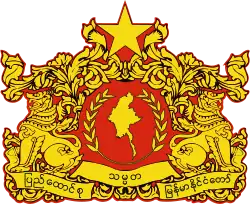| ||
80 of the 103 seats in the Legislative Council | ||
|---|---|---|
| Turnout | 18% | |
|
| ||
 |
|---|
|
|
Legislative Council elections were held in Burma in November 1928. Despite expectations that pro-government candidates would win,[1] the result was a victory for the opposition, which won 45 of the 80 elected seats. However, the People's Party, the largest opposition party, was unable to form a government.[2] Instead, the pro-British Independent Party formed the government.[2]
Electoral system
The Legislative Council had 80 elected members, who were elected in 72 constituencies.[3] Around 55% of the adult population of the country was eligible to vote in the elections.[3] Women remained barred from standing as candidates, provoking a public protest by women at the Secretariat.[3]
Results
Opposition parties won 45 seats,[1] with the People's Party receiving the most votes.[2] Sixteen independents were elected, of whom nine were thought to be pro-opposition.[1] The pro-government parties and independents lost eight seats.[1]
Voter turnout was only 18%.[4]
| Party | Seats | +/– | |
|---|---|---|---|
| People's Party | 40 | –5 | |
| Independent Party | 12 | –8 | |
| National Parliamentary Organisation | 5 | New | |
| Others | 46 | – | |
| Total | 103 | 0 | |
| Source: Haruhiro Fukui[5] | |||
References
- 1 2 3 4 "Burmese Elections. Gains By The Opposition", The Times, 15 November 1928, p15, Issue 45051
- 1 2 3 Here Today, Gone Tomorrow The Irrawaddy, 3 November 2009
- 1 2 3 "Simon Commission In Burma. Women And Public Life" The Times, 1 February 1929, p11, Issue 45116
- ↑ Robert H Taylor (2009) The State in Myanmar NUS Press, p185
- ↑ Haruhiro Fukui (1985) Political parties of Asia and the Pacific, Greenwood Press, pp106–154